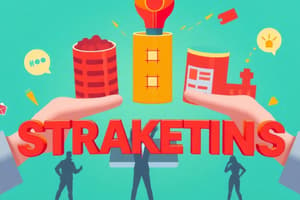Podcast
Questions and Answers
Which of the following is NOT an example of direct marketing?
Which of the following is NOT an example of direct marketing?
- Telemarketing calls
- Social media advertisements (correct)
- Email marketing campaigns
- Catalog distribution
Buzz marketing primarily relies on which form of promotion?
Buzz marketing primarily relies on which form of promotion?
- Paid advertisements in magazines
- One-on-one sales presentations
- Traditional television ads
- Word-of-mouth or viral marketing (correct)
What is a characteristic of a two-way communication model?
What is a characteristic of a two-way communication model?
- Information flowing only from sender to receiver
- A feedback loop allowing for interaction (correct)
- Using multiple communication channels simultaneously
- Absence of audience involvement
Emotional appeals in marketing communication aim to:
Emotional appeals in marketing communication aim to:
Advertising differs from other forms of marketing communication in that it is:
Advertising differs from other forms of marketing communication in that it is:
What best defines a target market?
What best defines a target market?
What is the primary focus of branding?
What is the primary focus of branding?
Market positioning chiefly deals with:
Market positioning chiefly deals with:
What is typically included in a company’s mission statement?
What is typically included in a company’s mission statement?
In B2B marketing, what is often the main emphasis?
In B2B marketing, what is often the main emphasis?
What describes the practice of penetration pricing?
What describes the practice of penetration pricing?
Which pricing strategy is characterized by initially high prices that decrease over time?
Which pricing strategy is characterized by initially high prices that decrease over time?
Value-based pricing is mainly focused on:
Value-based pricing is mainly focused on:
What is a product line?
What is a product line?
Which of the following is considered a convenience product?
Which of the following is considered a convenience product?
What does brand equity refer to?
What does brand equity refer to?
Which option illustrates brand loyalty?
Which option illustrates brand loyalty?
What is called when a brand uses its name to introduce a new product in a different category?
What is called when a brand uses its name to introduce a new product in a different category?
What is the nature of a private label brand?
What is the nature of a private label brand?
What is a key benefit of strong brand loyalty?
What is a key benefit of strong brand loyalty?
Which of the following represents a direct distribution channel?
Which of the following represents a direct distribution channel?
Dividing a market based on variables like age, gender, income, and education level is known as:
Dividing a market based on variables like age, gender, income, and education level is known as:
Dividing a market based on how customers use a product, such as frequency of purchase, is an example of:
Dividing a market based on how customers use a product, such as frequency of purchase, is an example of:
Which type of segmentation is focused on grouping customers based on their attitudes, opinions, and interests?
Which type of segmentation is focused on grouping customers based on their attitudes, opinions, and interests?
A brand targeting fitness enthusiasts and health-conscious consumers is most likely using which segmentation?
A brand targeting fitness enthusiasts and health-conscious consumers is most likely using which segmentation?
Which stage of the product life cycle is typically associated with the highest levels of competition?
Which stage of the product life cycle is typically associated with the highest levels of competition?
Which of the following is an example of a convenience product?
Which of the following is an example of a convenience product?
In marketing, a product can be defined as:
In marketing, a product can be defined as:
What are the stages of the Product Life Cycle (PLC)?
What are the stages of the Product Life Cycle (PLC)?
What is the main advantage of direct distribution?
What is the main advantage of direct distribution?
Which of the following is NOT a type of distribution channel?
Which of the following is NOT a type of distribution channel?
What does supply chain management primarily involve?
What does supply chain management primarily involve?
Which of the following is NOT typically considered in demographic segmentation?
Which of the following is NOT typically considered in demographic segmentation?
Which segmentation strategy would best suit a luxury car brand?
Which segmentation strategy would best suit a luxury car brand?
What does a niche marketing strategy focus on?
What does a niche marketing strategy focus on?
Which of the following best describes a differentiated targeting strategy?
Which of the following best describes a differentiated targeting strategy?
Flashcards
Target Market
Target Market
A specific group of customers that a business aims to serve.
Branding
Branding
Creating a unique name, symbol, or design to identify a product and build a brand image.
Market Positioning
Market Positioning
How a product is perceived in the customer's mind compared to competitors.
Mission Statement
Mission Statement
Signup and view all the flashcards
B2B Marketing
B2B Marketing
Signup and view all the flashcards
Penetration Pricing
Penetration Pricing
Signup and view all the flashcards
Price Skimming
Price Skimming
Signup and view all the flashcards
Value-Based Pricing
Value-Based Pricing
Signup and view all the flashcards
Demographic Segmentation
Demographic Segmentation
Signup and view all the flashcards
Behavioral Segmentation
Behavioral Segmentation
Signup and view all the flashcards
Psychographic Segmentation
Psychographic Segmentation
Signup and view all the flashcards
Product Life Cycle
Product Life Cycle
Signup and view all the flashcards
Convenience Product
Convenience Product
Signup and view all the flashcards
Product Mix
Product Mix
Signup and view all the flashcards
Introduction Stage
Introduction Stage
Signup and view all the flashcards
Growth Stage
Growth Stage
Signup and view all the flashcards
Direct Marketing
Direct Marketing
Signup and view all the flashcards
Two-way Communication
Two-way Communication
Signup and view all the flashcards
Emotional Appeals
Emotional Appeals
Signup and view all the flashcards
Advertising
Advertising
Signup and view all the flashcards
Brand Equity
Brand Equity
Signup and view all the flashcards
Brand Loyalty
Brand Loyalty
Signup and view all the flashcards
Brand Extension
Brand Extension
Signup and view all the flashcards
Brand Logo
Brand Logo
Signup and view all the flashcards
Private Label Brand
Private Label Brand
Signup and view all the flashcards
Selective Distribution
Selective Distribution
Signup and view all the flashcards
Direct Distribution
Direct Distribution
Signup and view all the flashcards
Types of Distribution Channels
Types of Distribution Channels
Signup and view all the flashcards
Supply Chain Management
Supply Chain Management
Signup and view all the flashcards
Luxury Car Segmentation
Luxury Car Segmentation
Signup and view all the flashcards
Niche Marketing
Niche Marketing
Signup and view all the flashcards
Differentiated Targeting
Differentiated Targeting
Signup and view all the flashcards
Study Notes
Target Market and Branding
- A target market is the group of customers a business aims to serve
- Branding involves creating a unique name, symbol, or design to identify a product
Market Positioning
- Market positioning focuses on how a product is perceived by customers
- It's not about the location of a business, but how customers view the product
Mission Statements
- A company's mission statement includes the company's core values and purpose
B2B Marketing Focus
- In Business-to-Business (B2B) marketing, the primary focus is building long-term relationships and value
Social Media Marketing Advantages
- Social media allows for direct engagement with a large audience.
Pricing Strategies
- Penetration Pricing: Setting low prices to quickly capture market share
- Price Skimming: Setting high initial prices for new products
- Value-Based Pricing: Pricing based on the perceived value of the product to the customer.
Segmentation
- Segmentation divides markets based on characteristics like demographics (age, gender, income)
- Psychographic segmentation focuses on attitudes, opinions, and interests.
- Common segmentation bases include demographics, geographic area, and psychographics.
- Competitor-based segmentation is less common.
Product Life Cycle (PLC)
- The PLC stages are Introduction, Growth, Maturity, and Decline
- Maturity is the stage with the highest levels of competition
Convenience Products
- Examples of convenience products include groceries and other everyday items
Product Mix & Line
- The product mix refers to the range of products offered by a company
- A product line is a series of related products marketed as a group
Brand Equity
- Brand equity is the perceived value of the brand that goes beyond its functional benefits
- Strong brand loyalty leads to greater customer retention and repeat purchases
Brand Loyalty
- Brand loyalty is when customers consistently purchase from a specific brand, even with other options available
- One example of brand loyalty is customers consistently buying a particular brand despite other options with similar attributes.
Distribution Channels
- Selective distribution uses a limited number of intermediaries to reach customers
- Direct distribution eliminates intermediaries, allowing for greater control
- Intensive distribution involves using all available channels to reach most customers
- Exclusive distribution restricts distribution to a single retailer or intermediary
Supply Chain Management
- Supply chain management is the process of coordinating the flow of goods, information, and finances in the supply chain
Demographic Segmentation vs Other
- Demographic segmentation considers factors like age, gender, and income while other, like psychographic segmentation, consider customer behaviors, opinions, and lifestyle choices to organize and categorize groups.
Target Market vs Other
- A target market is a specific group of customers a company wants to reach whereas a market is the total group of customers a company could serve.
Marketing Communication Types
- Advertising is paid and directed towards a broad audience
- Sales promotions include incentives
Studying That Suits You
Use AI to generate personalized quizzes and flashcards to suit your learning preferences.




